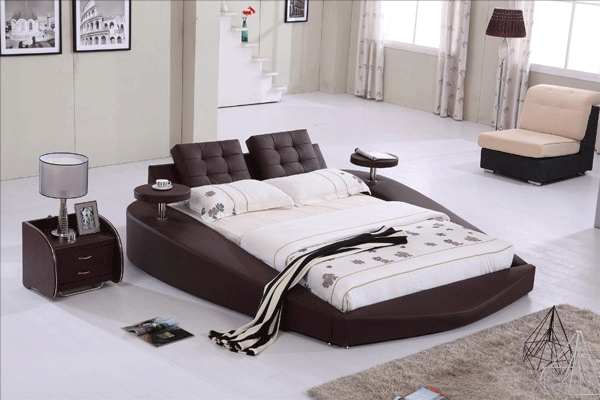As more and more people strive towards spending more time outside, various outdoor activities are becoming more popular. Spending time in nature that includes finding treasures makes for the perfect hobby. That’s why gold prospecting and gold panning alone are trending hobbies. Gold itself isn’t as exciting as the process of hunting for it. Those little flakes and nuggets of gold come as a reward for digging in the riverbeds and making mud pies all day long.
No matter their technique for prospecting gold, a gold pan is a tool every prospector needs. What are the different types of gold pans, and how can you choose the right one for you? To know this, you must first learn what’s panning and how does a gold pan work?
What’s Gold Panning?
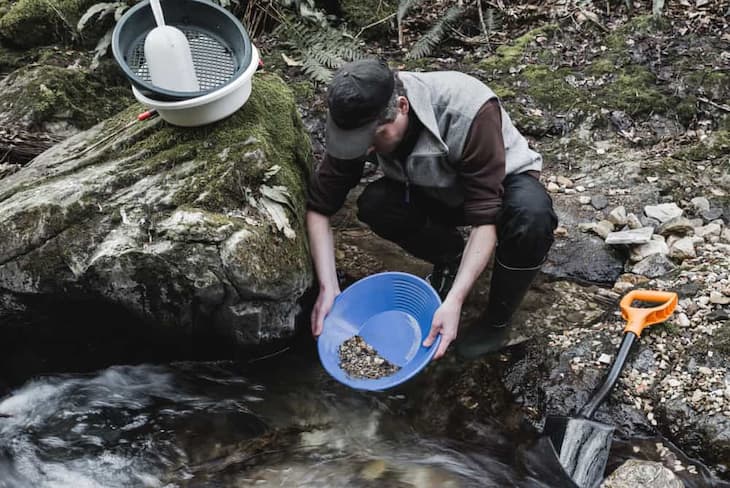
Gold panning, also known as panning, is a form of gold mining that first started in ancient Rome. It’s a simple process that involves extracting gold from a placer deposit using a gold pan. Gold miners use panning as a part of more complicated mining operations and as a sole technique. It’s very popular among geology and gold mining enthusiasts due to its low cost and simplicity. Gold panning kits are very simple to use: it doesn’t take a long time to master your technique once you start panning.
What Does a Gold Pan Do?
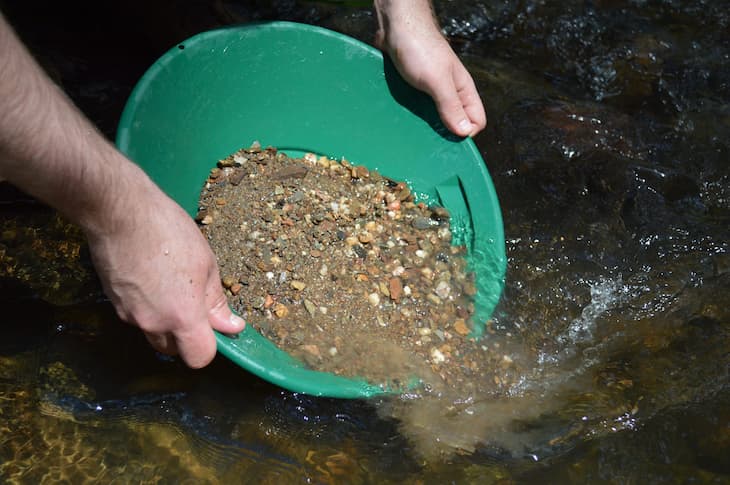
Gold is relatively heavier than other metals and ground compounds, making it easy to recover with a pan. How exactly do you do that? You need to shovel some gravel and sand from where you suspect to find gold and then put it in the pan. Then, you need to first remove the big rocks and shake the remaining materials. Whether you shake side to side or you swirl it around doesn’t make much difference; it’s a matter of personal preference. What’s more important is to ensure if there’s any gold on the bottom after the pan full of material has become settled and stationary. Make sure you check carefully after you wash away the liftest materials on top.
Now that you know how panning works, you see the importance of a gold pan. So, what should you look for when you decide to buy gold pan to find your treasures?
Comparing the Different Types of Gold Pans
Plastic vs Metal
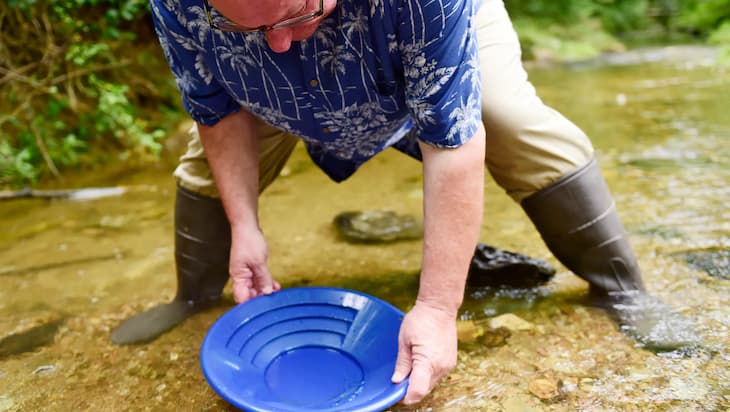
In terms of material, there are plastic and metal gold pans today.
Plastic gold pans are the first choice of many gold diggers as they’re lightweight, durable and difficult to break. They also come in a variety of riffle patterns, which makes separating the gold nuggets easier. Some other benefits are that they float and won’t rust. When you have a plastic pan, you can also use a magnet on the other side of the bottom to separate gold flakes from sand, which is how many prefer.
Knowing the benefits of plastic pans, you may ask yourself if anyone still uses the metal ones. Yes, metal pans still appeal to many users. The main reason is nostalgia: many prospectors want to use the same equipment as the original gold diggers used in the gold rushes in the 19th century. One thing to remember is that they don’t have rifles, so you need to advance your technique to use a metal pan successfully. Another thing is that they rust, so they need more effort in terms of maintenance. Many use seasoning, and others blacken them.
Different Riffle Patterns
The injection moulding process available today can create virtually any form we like. The manufacturing processes used in the past weren’t like those we have today, which means that there was no such thing as riffled pans before. Today, we have different riffled pans to capture gold. They aren’t necessary for success but can be very helpful, especially if you haven’t developed your technique fully. They’re so forgiving towards beginners that some people call them cheater riffles.
There are pans with small and big riffles and multi riffle gold pans. The riffle system dramatically impacts the ability of the pan to catch gold, so you should choose the one that will best serve your needs and goals.
Small riffles are best for processing material with a lot of fine gold. They’re also suitable for cleaning up concentrates from gold sluices and dredge cleanups. On the other hand, they aren’t good at processing large amounts of material.
Bigg riffles are best for coarse materials, which allows you to process large quantities of material quicker. However, they aren’t suitable for fine gold and aren’t the first choice for panning concentrates.
Multiriffle gold pans include both big and small riffles, making them very versatile. These offer a reasonable compromise between the two, as it allows both versions in one pan.
Different Sizes
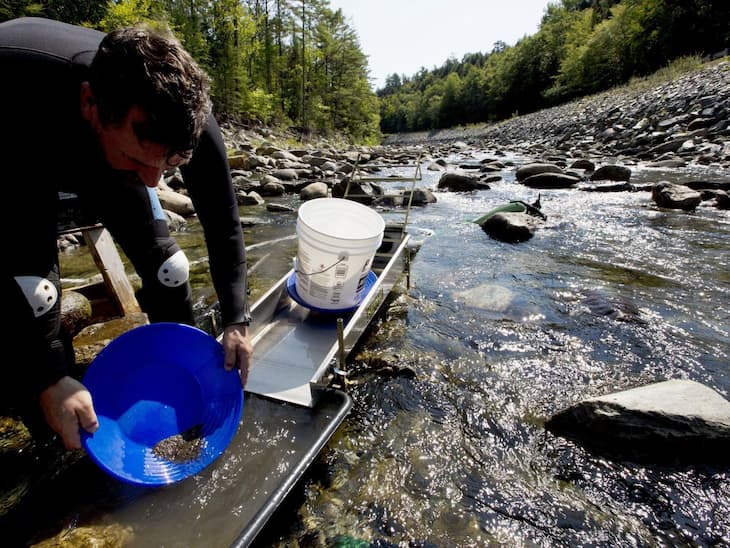
Although most gold pans range from 10 to 24 inches in diameter, the most commonly used size is around 14-16 inches.
Large-sized pans are considered pans that have 15-24 inches in diameter. It’s obvious that the larger the gold pan, the more material you can process with it. If you are using a gold pan as your primary processing tool, it’s reasonable to get one above 16 inches.
However, using some other tools, such as a sluice box, can process up to 200 times more material in the same amount of time. The recommendation is to use a sluice box combined with a gold pan for larger amounts of material than a pan only. This can save you time, allow you to easily operate with one hand and use a smaller pan at around 10-12 inches.
Conventional pans at around 14-16 inches strike a nice balance between ease of use, portability, and processing ability. If you were to choose just one gold pan, they’re a great choice.
Different Colours
Does the colour of the gold pan matter? Typical colours for gold pans are blue, black, green and pink. These colours ensure the gold is visible so it can be spotted easily. The colour choice is a personal preference. Yet, make sure to buy gold pan colour that doesn’t blend in with the environment you are working with. That way, you won’t forget to pack down your pan because it becomes invisible against the surrounding.

